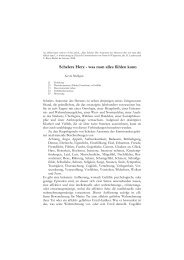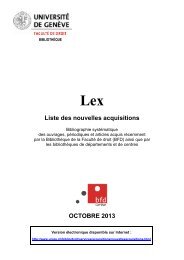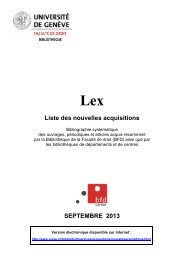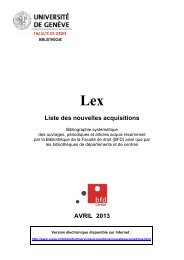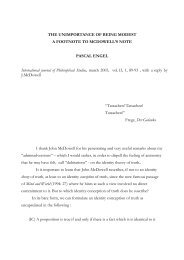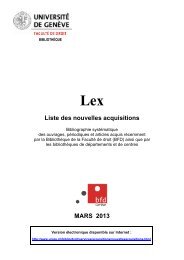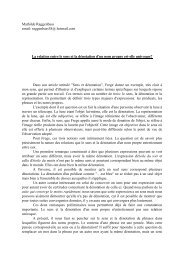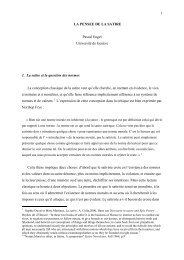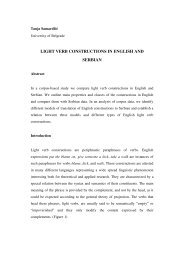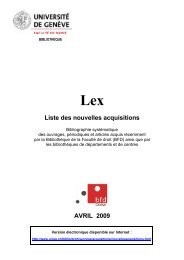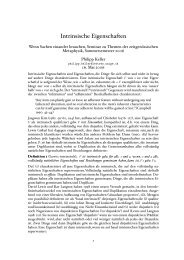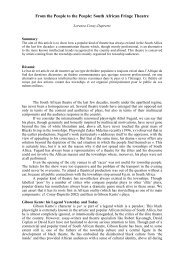Self-Assembly of Amphiphilic Calix[4]arenes in Aqueous Solution
Self-Assembly of Amphiphilic Calix[4]arenes in Aqueous Solution
Self-Assembly of Amphiphilic Calix[4]arenes in Aqueous Solution
Create successful ePaper yourself
Turn your PDF publications into a flip-book with our unique Google optimized e-Paper software.
FULL PAPER<br />
DOI: 10.1002/adfm.200500212<br />
<strong>Self</strong>-<strong>Assembly</strong> <strong>of</strong> <strong>Amphiphilic</strong> <strong>Calix</strong>[4]<strong>arenes</strong> <strong>in</strong> <strong>Aqueous</strong> <strong>Solution</strong>**<br />
By Michael Strobel, Katarzyna Kita-Tokarczyk, Andreas Taubert, Cor<strong>in</strong>ne Vebert, Paul A. He<strong>in</strong>ey,<br />
Mohamed Chami, and Wolfgang Meier*<br />
The self-assembly <strong>of</strong> amphiphilic calix[4]<strong>arenes</strong> with either a carboxylic acid or a trimethyl ammonium head group and different<br />
alkyl cha<strong>in</strong>s <strong>in</strong> aqueous solution was <strong>in</strong>vestigated. The carboxylated calixarene forms vesicles <strong>in</strong> dilute solution and stable<br />
monolayers on water. In contrast, the ammonium head group provides high water solubility with no observed aggregation. At<br />
high concentrations, all calixarene amphiphiles form lyotropic liquid crystals.<br />
1. Introduction<br />
<strong>Calix</strong><strong>arenes</strong> are monodisperse, easily synthesized, and easily<br />
purified <strong>in</strong> large amounts. <strong>Amphiphilic</strong> calix<strong>arenes</strong> are “surfactants<br />
with a host–guest recognition site”, [1] which is attractive<br />
for applications where a guest molecule must be stabilized,<br />
transported, or protected <strong>in</strong> aqueous media. As amphiphilic calix<strong>arenes</strong><br />
can <strong>in</strong>teract with aqueous systems, they are <strong>of</strong> particular<br />
<strong>in</strong>terest for biological and environmental applications, e.g.,<br />
wastewater treatment, medical diagnosis, and highly sensitive<br />
and selective sensors. [2,3] There have thus been some studies on<br />
amphiphilic calix<strong>arenes</strong> <strong>in</strong> aqueous solution, [1,4–15] but few calixarene-based<br />
gels have been reported, [16,17] although such gels<br />
could, for example, enable the <strong>in</strong>corporation <strong>of</strong> pharmaceutically<br />
active compounds <strong>in</strong>to o<strong>in</strong>tments. In the same context,<br />
liquid-crystall<strong>in</strong>e calix<strong>arenes</strong> are <strong>in</strong>terest<strong>in</strong>g, but so far only a<br />
few calixarene-based LCs have been reported. [18–26]<br />
Most reports on amphiphilic calix<strong>arenes</strong> have been on dilute<br />
aqueous solutions. For example, <strong>in</strong> an early small-angle X-ray<br />
scatter<strong>in</strong>g (SAXS) study <strong>of</strong> sulfonated calix[6]arene amphiphiles,<br />
Sh<strong>in</strong>kai et al. [1] observed micelles. More recently, Kellermann<br />
et al. [5] have reported uniform and monodisperse micelles;<br />
mixed micelles have also been described, [27] and Capuzzi<br />
– [*] Pr<strong>of</strong>. W. Meier, Dr. M. Strobel, Dr. K. Kita-Tokarczyk, [+]<br />
Dr. A. Taubert, Dr. C. Vebert<br />
Department <strong>of</strong> Chemistry, Biozentrum, University <strong>of</strong> Basel<br />
CH-4056 Basel (Switzerland)<br />
E-mail: wolfgang.meier@unibas.ch<br />
Pr<strong>of</strong>. P. A. He<strong>in</strong>ey<br />
Department <strong>of</strong> Physics and Astronomy, University <strong>of</strong> Pennsylvania<br />
Philadelphia, PA 19104 (USA)<br />
Dr. M. Chami<br />
M.E. Müller Institute for Microscopy, Biozentrum, University <strong>of</strong> Basel<br />
CH-4056 Basel (Switzerland)<br />
[+] Current address: Faculty <strong>of</strong> Chemistry, Jagiellonian University,<br />
Ingardena 3, PL-30-060 Krakow, Poland.<br />
[**] We acknowledge Pr<strong>of</strong>. W. B. Stern (University <strong>of</strong> Basel) for prelim<strong>in</strong>ary<br />
X-ray experiments at the Earth Sciences Department. This work<br />
was funded by the Swiss National Science Foundation and the NCCR<br />
Nanosciences. P. A. H. acknowledges f<strong>in</strong>ancial support by the National<br />
Science Foundation (DMR-0102459). Support<strong>in</strong>g Information<br />
is available onl<strong>in</strong>e from Wiley InterScience or from the author.<br />
et al. [11] have <strong>in</strong>vestigated selective counterion complexation<br />
by calix[4]arene-crown ether micelles. While most <strong>of</strong> these<br />
studies report the formation <strong>of</strong> micelles, three studies describe<br />
the formation <strong>of</strong> vesicles from calix<strong>arenes</strong>. [6,8,9] Vesicular structures<br />
should attract attention because they may have applications<br />
similar to lipid vesicles or self-assembled polymers, which<br />
have been widely promoted as, e.g., drug-delivery systems. [28–30]<br />
The goal <strong>of</strong> this current study was thus to synthesize amphiphilic<br />
calix<strong>arenes</strong> and to study their self-assembly <strong>in</strong> aqueous<br />
solution. We have studied the amphiphilic calix[4]<strong>arenes</strong> 4, 5a,<br />
and 5b (Scheme 1) <strong>in</strong> aqueous solution and at the air/water<br />
<strong>in</strong>terface us<strong>in</strong>g a wide variety <strong>of</strong> experimental techniques. For<br />
the reasons mentioned above, a particular focus was the formation<br />
and <strong>in</strong>vestigation <strong>of</strong> vesicular structures.<br />
2. Results<br />
2.1. <strong>Self</strong>-<strong>Assembly</strong> <strong>in</strong> Dilute <strong>Solution</strong>s<br />
We will first present the results obta<strong>in</strong>ed from dilute calixarene<br />
solutions. Figure 1 shows the static and dynamic light scatter<strong>in</strong>g<br />
(LS) data <strong>of</strong> calixarene 4 <strong>in</strong> 0.1 M NH3(aq). The hydrodynamic<br />
radius R h <strong>of</strong> the aggregates is 43 nm, as calculated<br />
from the Stokes–E<strong>in</strong>ste<strong>in</strong> equation us<strong>in</strong>g the diffusion coefficient<br />
obta<strong>in</strong>ed after extrapolation to zero concentration, Figure<br />
1a. [31] The polydispersity <strong>in</strong>dex is approximately 1.2 for all<br />
samples, which is common for vesicles.<br />
The concentration (c) pr<strong>of</strong>ile <strong>of</strong> the <strong>in</strong>verse scatter<strong>in</strong>g <strong>in</strong>tensity,<br />
Figure 1b, is l<strong>in</strong>ear. As a result, the critical aggregation<br />
concentration (cac) is below the detection limit <strong>of</strong> our lightscatter<strong>in</strong>g<br />
experiments. Zimm analysis yielded a radius <strong>of</strong> gyration<br />
R g <strong>of</strong> 58 nm and a weight-average molecular weight (M w)<br />
<strong>of</strong> about 10 7 g mol –1 for the aggregates, i.e., the aggregation<br />
number is ca. 7800. Interest<strong>in</strong>gly, the scatter<strong>in</strong>g <strong>in</strong>tensity <strong>of</strong> solutions<br />
<strong>of</strong> 5a and 5b was too low for analysis even at a concentration<br />
<strong>of</strong> 500 mg mL –1 . These LS measurements are further<br />
complicated by the low <strong>in</strong>dex <strong>of</strong> refraction <strong>in</strong>crement.<br />
Figure 2 is a cryo-TEM (transmission electron microscopy)<br />
image <strong>of</strong> 4 <strong>in</strong> 0.1 M NH 3(aq). The sample is a mixture <strong>of</strong> large<br />
and small vesicles, distorted vesicles, and isolated lamellae; the<br />
252 © 2006 WILEY-VCH Verlag GmbH & Co. KGaA, We<strong>in</strong>heim Adv. Funct. Mater. 2006, 16, 252–259
M. Strobel et al./<strong>Self</strong>-<strong>Assembly</strong> <strong>of</strong> <strong>Amphiphilic</strong> <strong>Calix</strong>[4]<strong>arenes</strong> <strong>in</strong> <strong>Aqueous</strong> <strong>Solution</strong><br />
Scheme 1. <strong>Calix</strong>arene amphiphile synthesis.<br />
Figure 1.a) Scaleddiffusioncoefficient(KD)andb) <strong>in</strong>versescatter<strong>in</strong>g<strong>in</strong>tensity<br />
(Kc/R),Kistheopticalconstant,RistheRayleighratio)<strong>of</strong>4<strong>in</strong>0.1 MNH3(aq).<br />
Figure 2. Cryo-TEM image <strong>of</strong> self-assembled structures <strong>of</strong> 4 <strong>in</strong> 0.1 N<br />
NH 3(aq): 1) large vesicle, 2) small vesicle, 3) distorted vesicle, and 4) isolated<br />
lamella or rod-like micelle.<br />
latter can also be <strong>in</strong>terpreted as rod-like micelles. As <strong>in</strong> previous<br />
studies, multilayer vesicles are not observed. [6,8,9] It must<br />
be stressed at this po<strong>in</strong>t that, unlike <strong>in</strong> other studies, the vesicles<br />
form spontaneously, i.e., simply after dissolution <strong>in</strong> aqueous<br />
solvents without further treatment, such as sonication etc.<br />
Despite the wide variety <strong>of</strong> shapes and sizes, the membrane<br />
thickness <strong>of</strong> the vesicles and the diameter <strong>of</strong> the presumed rodlike<br />
micelles is uniform, rang<strong>in</strong>g from 37 to 50 Å. Simple calculations<br />
<strong>of</strong> the length <strong>of</strong> the monomeric unit <strong>of</strong> 4, 5a, and 5b<br />
us<strong>in</strong>g ChemOffice Chem3D give lengths <strong>of</strong> 17.1, 19.9, and<br />
22.0 Å, respectively, if the alkyl cha<strong>in</strong> is fully extended, Figure<br />
3. These calculations are consistent with the bilayer thickness<br />
observed <strong>in</strong> the TEM: a bilayer <strong>of</strong> 4 is approximately 40 Å<br />
thick from the calculations, which is consistent with the 37 to<br />
50 Å observed <strong>in</strong> the TEM.<br />
2.2. <strong>Self</strong>-<strong>Assembly</strong> at the Air/Water Interface<br />
Before present<strong>in</strong>g the results from concentrated bulk aqueous<br />
solutions, we will focus on the self-assembly <strong>of</strong> the calix<strong>arenes</strong><br />
at the air/water <strong>in</strong>terface. These studies provide further<br />
<strong>in</strong>sight <strong>in</strong>to why, <strong>in</strong> dilute solution, 4 forms vesicles and 5a,5b<br />
do not seem to form any aggregates that can be detected either<br />
with LS analysis or TEM.<br />
Figure 4 shows the surface pressure (p)–area (A) isotherms<br />
and the correspond<strong>in</strong>g surface potentials <strong>of</strong> 4 and 5a on water.<br />
4 and 5a form condensed monolayers and exhibit no evident<br />
phase transitions <strong>in</strong> the low-surface-pressure region. However,<br />
the isotherms vary strongly as a function <strong>of</strong> the head group.<br />
i) Only the isotherm <strong>of</strong> 5a has a dist<strong>in</strong>ct and reproducible plateau<br />
at high p. ii) 5a has a larger lift-<strong>of</strong>f area than 4 (50 Å 2 versus<br />
20 Å 2 , respectively). iii) The mean area per unit monomer<br />
<strong>of</strong> 4 and 5a differs with the number <strong>of</strong> molecules spread at the<br />
<strong>in</strong>terface and with the compression speed (data not shown).<br />
The lift-<strong>of</strong>f area is smaller upon slow compression, and when a<br />
small amount <strong>of</strong> 4 or 5a is spread. These differences are more<br />
significant <strong>in</strong> the case <strong>of</strong> 5a, the compound <strong>of</strong> higher water<br />
Adv. Funct. Mater. 2006, 16, 252–259 © 2006 WILEY-VCH Verlag GmbH & Co. KGaA, We<strong>in</strong>heim www.afm-journal.de 253<br />
FULL PAPER
FULL PAPER<br />
Figure 3. Calculated monomeric units with fully extended alkyl tails. The<br />
head group <strong>of</strong> 4 is ca. 4.4 Å wide if one takes <strong>in</strong>to account that the benzene<br />
r<strong>in</strong>gs cannot be closer than their outermost hydrogens. The head<br />
groups <strong>of</strong> 5a and 5b are ca. 4.3 Å wide. Element code: gray—carbon,<br />
red—oxygen, dark blue—nitrogen, light blue—hydrogen, green—chlor<strong>in</strong>e.<br />
Figure 4. p–A isotherms <strong>of</strong> 4 and 5a with correspond<strong>in</strong>g surface potentials.<br />
M. Strobel et al./<strong>Self</strong>-<strong>Assembly</strong> <strong>of</strong> <strong>Amphiphilic</strong> <strong>Calix</strong>[4]<strong>arenes</strong> <strong>in</strong> <strong>Aqueous</strong> <strong>Solution</strong><br />
solubility. iv) The surface potential (DV) <strong>in</strong>creases before p<br />
<strong>in</strong>creases. The surface potential <strong>in</strong>crease <strong>of</strong> 4 is l<strong>in</strong>ear <strong>in</strong> the<br />
expanded phase region, and a small k<strong>in</strong>k is observed at the lift<strong>of</strong>f<br />
area. Maximum surface potential, correspond<strong>in</strong>g to the<br />
most-vertical orientation <strong>of</strong> the hydrophobic cha<strong>in</strong>s, is reached<br />
at ca. 20 Å 2 . Further compression leads to a p <strong>in</strong>crease,<br />
whereas DV slightly decreases. 5a already exhibits a l<strong>in</strong>ear DV<br />
<strong>in</strong>crease <strong>in</strong> the expanded phase, but at the onset <strong>of</strong> the plateau<br />
<strong>in</strong> the p isotherm, DV decreases slightly.<br />
Not only the isotherms but also the film stability varied<br />
strongly with the head group: dur<strong>in</strong>g subsequent compression/<br />
expansion cycles, a significant amount <strong>of</strong> 5a desorbed irreversibly<br />
<strong>in</strong>to the subphase, as is shown <strong>in</strong> a constant-area experiment<br />
(see Support<strong>in</strong>g Information).<br />
At the Brewster angle (53° for the air/water <strong>in</strong>terface), the<br />
monolayer morphology can be imaged based on the <strong>in</strong>tensity<br />
<strong>of</strong> the p-polarized light reflected from the <strong>in</strong>terface. The image<br />
grayscale can be related to different organization <strong>of</strong> the molecules<br />
at the <strong>in</strong>terface. Figure 5 shows that at zero surface pressure,<br />
gaseous (dark) and expanded liquid (gray) phases coexist<br />
<strong>in</strong> monolayers <strong>of</strong> 4. At the lift-<strong>of</strong>f area (ca. 18 Å 2 ) the gaseous<br />
phase disappears, but no ideally homogeneous monolayer<br />
forms. Instead, monolayer fragments and a ‘rough’ (more reflect<strong>in</strong>g)<br />
texture are visible, <strong>in</strong>dicat<strong>in</strong>g a change <strong>in</strong> molecular<br />
pack<strong>in</strong>g. Bright stripe-like structures appear and grow above<br />
the ‘k<strong>in</strong>k’ pressure at 42 mN m –1 . Eventually, the monolayer<br />
collapses. With 5a (data not shown), we observed an ideally<br />
smooth monolayer throughout the compression, but no larger<br />
features.<br />
Figure 5. Brewster angle microscopy (BAM) images <strong>of</strong> 4 at <strong>in</strong>creas<strong>in</strong>g surface<br />
pressures.<br />
254 www.afm-journal.de © 2006 WILEY-VCH Verlag GmbH & Co. KGaA, We<strong>in</strong>heim Adv. Funct. Mater. 2006, 16, 252–259
M. Strobel et al./<strong>Self</strong>-<strong>Assembly</strong> <strong>of</strong> <strong>Amphiphilic</strong> <strong>Calix</strong>[4]<strong>arenes</strong> <strong>in</strong> <strong>Aqueous</strong> <strong>Solution</strong><br />
2.3. <strong>Self</strong>-<strong>Assembly</strong> <strong>in</strong> Concentrated <strong>Solution</strong><br />
Figures 6,7 are optical micrographs <strong>of</strong> 5a <strong>in</strong> water (70:30 w/w)<br />
and 4 <strong>in</strong> 5 N NH 3(aq) (63:37 w/w), respectively. All images<br />
show birefr<strong>in</strong>gence <strong>in</strong>dicative <strong>of</strong> a liquid crystal (LC); the textures<br />
are however rather non-descript, which makes it difficult<br />
to def<strong>in</strong>itely assign a LC phase to the materials. We expla<strong>in</strong> the<br />
lack <strong>of</strong> a characteristic texture with the high viscosity <strong>of</strong> the respective<br />
samples. The LCs are stable between 50 and 80 wt.-%<br />
(calixarene 4) and 55 and 80 wt.-% (calixarene 5a) from 5 to<br />
80 °C. Figure 8 is an approximate phase diagram <strong>of</strong> 4 and 5a.<br />
This is, to the best <strong>of</strong> the authors’ knowledge, the first lyotropic<br />
LC <strong>of</strong> calix<strong>arenes</strong> reported.<br />
Figure 9 is an X-ray pattern <strong>of</strong> a 60:40 (w/w) mixture <strong>of</strong> 4<br />
<strong>in</strong> 3 N NH3(aq). The pattern exhibits a s<strong>in</strong>gle sharp peak at<br />
q =0.161 Å –1 , correspond<strong>in</strong>g to a d-spac<strong>in</strong>g <strong>of</strong> 39 Å. Such a<br />
pattern is characteristic <strong>of</strong> a lamellar lyotropic LC, and the<br />
Figure 6. A 70:30 (w/w) mixture <strong>of</strong> 5a <strong>in</strong> water between crossed polarizers.<br />
Figure 7. A 63:37 (w/w) mixture <strong>of</strong> 4 <strong>in</strong> 5 N NH 3(aq) between crossed polarizers.<br />
Figure 8. Phase diagrams <strong>of</strong> 4 and 5a.<br />
Figure 9. X-ray pattern <strong>of</strong> a 60:40 (w/w) mixture <strong>of</strong> 4 <strong>in</strong> 3 N NH3(aq) at<br />
room temperature.<br />
d-spac<strong>in</strong>g is consistent with the cryo-TEM measurements on<br />
dilute solutions <strong>of</strong> 4, which <strong>in</strong>dicate vesicle wall thickness <strong>of</strong><br />
37–50 Å. The X-ray data are also consistent with the calculated<br />
bilayer thickness <strong>of</strong> ca. 40 Å. However, due to the<br />
absence <strong>of</strong> higher-order peaks this assignment must be considered<br />
prelim<strong>in</strong>ary.<br />
In contrast to 4, the X-ray pattern <strong>of</strong> 5a (see Support<strong>in</strong>g<br />
Information) exhibits a more complex pattern with at least<br />
5 dist<strong>in</strong>ct (albeit broad) peaks. A complete analysis requires<br />
more diffraction peaks and further experimental data on<br />
the aggregate shape <strong>in</strong> solution from LS. However, the<br />
X-ray pattern is consistent with a rectangular columnar<br />
structure.<br />
Adv. Funct. Mater. 2006, 16, 252–259 © 2006 WILEY-VCH Verlag GmbH & Co. KGaA, We<strong>in</strong>heim www.afm-journal.de 255<br />
FULL PAPER
FULL PAPER<br />
3. Discussion<br />
3.1. Dilute <strong>Solution</strong>s<br />
Unlike many lipids, surfactants, or amphiphilic block copolymers<br />
<strong>in</strong> dilute aqueous solution, 4 spontaneously self-assembles<br />
<strong>in</strong>to unilamellar vesicles. Rg (58 nm) and Rh (43 nm) <strong>of</strong> 4 <strong>in</strong> dilute<br />
solution yield a q value (q = Rg/Rh) <strong>of</strong> 1.35. A q value <strong>of</strong> 1 is<br />
characteristic for hollow spheres, i.e., vesicles, and q = 2 is obta<strong>in</strong>ed<br />
for anisometric objects such as rods, however sample<br />
polydispersities <strong>of</strong> ca. 1.2 also affect q. [32] LS analysis thus <strong>in</strong>dicated<br />
the presence <strong>of</strong> a polydisperse mixture <strong>of</strong> objects with several<br />
shapes and sizes <strong>in</strong> dilute solutions <strong>of</strong> 4. Cryo-TEM confirmed<br />
the formation <strong>of</strong> vesicles and long th<strong>in</strong> features that<br />
could possibly be rod-like micelles. The vesicle shell thickness<br />
(or rod diameter) obta<strong>in</strong>ed from cryo-TEM was between 37 and<br />
50 Å. We concluded that the shells are calixarene bilayers because<br />
their thickness is similar to lipid bilayers (30 to 50 Å). [29]<br />
Furthermore, the calculated thickness <strong>of</strong> a bilayer <strong>of</strong> 4 is just below<br />
40 Å, also <strong>in</strong> agreement with the observed shell thickness.<br />
The uniform thickness <strong>in</strong>dicates that no multilayers form.<br />
The wide variety <strong>of</strong> shapes and sizes is consistent with a<br />
system with rather slow dynamics: <strong>in</strong> general, highly dynamic<br />
systems at or close to equilibrium rapidly undergo surfactant<br />
exchange and show uniform aggregate shapes and sizes. Systems<br />
with slow dynamics, however, exhibit rather broad shape<br />
and size distributions. The cryo-TEM images are therefore<br />
snapshots <strong>of</strong> assemblies attempt<strong>in</strong>g to reach equilibrium rather<br />
than assemblies at equilibrium.<br />
In contrast to 4, we did not observe aggregation <strong>of</strong> 5a or 5b.<br />
This suggests that 5a and 5b either do not aggregate or—more<br />
likely—form aggregates that are <strong>in</strong>visible <strong>in</strong> LS analysis and<br />
TEM. The calculated micelle radius (i.e., the length <strong>of</strong> one molecule)<br />
is 17 (5a) to22(5b) Å. These dimensions are too small for<br />
our LS setup, which has a lower detection limit <strong>of</strong> ca. 40 Å, but<br />
could be detected with small-angle X-ray scatter<strong>in</strong>g, small-angle<br />
neutron scatter<strong>in</strong>g (SANS), or improved cryo-TEM. Indeed<br />
some studies have detected calixarene micelle sizes between 30<br />
and 90 Å. [5,6,10,11] We therefore conclude that, as the hydrophobic<br />
parts <strong>of</strong> 4 and 5b are the same, the key parameter controll<strong>in</strong>g<br />
calixarene amphiphile self-assembly <strong>in</strong> aqueous solution is the<br />
head group. For vesicle formation, comparatively small head<br />
groups with relatively low charges are necessary. In our case,<br />
–COOH (or –COO – ) is smaller than the –CH 2N(CH 3) 3Cl group<br />
and is only partly ionized because it is a weak acid.<br />
Our f<strong>in</strong>d<strong>in</strong>gs thus support observations <strong>in</strong> which relatively<br />
hydrophobic calix<strong>arenes</strong> form vesicles with a s<strong>in</strong>gle bilayer<br />
membrane, and highly hydrophilic derivatives or derivatives<br />
with rather large hydrophilic groups form micelles. For example,<br />
Lee at al. [6] have shown that amphiphilic calix<strong>arenes</strong> with<br />
triethylene glycol tails at the head groups form micelles. In contrast,<br />
hydroxyethyl or diethylene glycol groups favor vesicles.<br />
The same group has also shown that protonation (<strong>in</strong>crease <strong>of</strong><br />
the head group charge) <strong>of</strong> tertiary am<strong>in</strong>e head groups drives<br />
the transition from vesicles to micelles.<br />
Our experiments at the air/water <strong>in</strong>terface confirm that the<br />
head group is a key parameter govern<strong>in</strong>g self-assembly: the<br />
M. Strobel et al./<strong>Self</strong>-<strong>Assembly</strong> <strong>of</strong> <strong>Amphiphilic</strong> <strong>Calix</strong>[4]<strong>arenes</strong> <strong>in</strong> <strong>Aqueous</strong> <strong>Solution</strong><br />
(apparently) small lift-<strong>of</strong>f area <strong>of</strong> 20 Å 2 for 4 is the area per<br />
monomer, i.e., a quarter <strong>of</strong> the whole calixarene. As the width<br />
<strong>of</strong> the head group <strong>of</strong> 4 is ca. 4.4 Å, the calculated mean molecular<br />
area is ca. 19.4 Å 2 , which agrees reasonably well with the<br />
experiment. The monomeric units <strong>of</strong> 4, 5a, and 5b are essentially<br />
surfactants with straight hydrocarbon cha<strong>in</strong>s, and their<br />
mean molecular area is <strong>in</strong>deed comparable to simple straightcha<strong>in</strong><br />
amphiphiles at the air/water <strong>in</strong>terface. The values also<br />
agree with other calix<strong>arenes</strong>. For example, the lift-<strong>of</strong>f area <strong>of</strong> a<br />
calix[4]arene with a crown ether head group is 23 Å 2 /monomer,<br />
[12] and 30 Å 2 /monomer has been reported for a tert-butyl<br />
calix[6]arene. [33] The latter area <strong>in</strong>crease is due to the bulky<br />
t-butyl group.<br />
Possible explanations for the lift-<strong>of</strong>f area differences between<br />
4 and 5a are i) ionic repulsion between the quaternary<br />
head groups and hence an <strong>in</strong>crease <strong>of</strong> the ammonium–ammonium<br />
group distance, and ii) the formation <strong>of</strong> hydrogen bonds <strong>in</strong><br />
monolayers <strong>of</strong> 4. This last <strong>in</strong>teraction could facilitate the formation<br />
<strong>of</strong> more compact layers with the carboxy head group<br />
than with the trimethyl ammonium head group and could lead<br />
to a decrease <strong>in</strong> the lift-<strong>of</strong>f area <strong>of</strong> 4. In contrast, ionic repulsion<br />
will <strong>in</strong>crease the calixarene–calixarene distance and thus<br />
<strong>in</strong>crease the lift-<strong>of</strong>f area <strong>of</strong> 5a.<br />
A broad plateau at ca. 35 mN m –1 characterizes the surface<br />
pressure isotherm <strong>of</strong> 5a. Such a plateau can <strong>in</strong>dicate a first-order<br />
phase transition, yet such transitions are normally observed<br />
at a lower p. Plateau regions <strong>in</strong> calixarene monolayers have<br />
been observed before. For example, the p–A isotherm <strong>of</strong> 1,3-dioctyloxy-calix[4]arene-crown-6-ether<br />
[12] has a plateau region at<br />
ca. 40 mN m –1 , which is attributed to monolayer collapse. On<br />
the other hand, He at al. [34] report the coexistence <strong>of</strong> monoand<br />
multilayers at 47 mN m –1 with 5,11,17,23-tetra-tert-butyl-<br />
25,27-di{[(2′-am<strong>in</strong>o-4′-methylthio)butyryl]am<strong>in</strong>oethoxy}-26,28dihydroxycalix[4]-arene.<br />
These authors suggest that there is a<br />
fold<strong>in</strong>g <strong>of</strong> the monolayer that leads to the formation <strong>of</strong> multilayers<br />
or other three-dimensional (3D) aggregates.<br />
For 5a, Brewster angle microscopy (BAM) rules out monolayer<br />
collapse at ca. 35 mN m –1 pressure, as the film rema<strong>in</strong>s<br />
smooth throughout the plateau and no doma<strong>in</strong>s are visible. We<br />
thus suggest that the plateau is not related to a monolayer transition<br />
or crystallization (LC formation). On the other hand,<br />
with the high solubility <strong>of</strong> the compound <strong>in</strong> water, the plateau<br />
at high surface pressure could be attributed to dissolution <strong>of</strong><br />
the monolayer material <strong>in</strong> the subphase, especially when no<br />
morphological changes are observed with BAM at 33 mN m –1 ,<br />
where the plateau beg<strong>in</strong>s. Additionally, this result is supported<br />
by the decreas<strong>in</strong>g surface potential <strong>in</strong> this region and the constant-area<br />
experiment, where p decreases over time (see Support<strong>in</strong>g<br />
Information).<br />
3.2. <strong>Self</strong>-<strong>Assembly</strong> <strong>in</strong> Concentrated <strong>Solution</strong><br />
All the studied calix<strong>arenes</strong> exhibited bulk lyotropic LC<br />
phases above ca. 50 wt.-% calixarene. They are layered <strong>in</strong> 4<br />
and rectangular <strong>in</strong> 5a,5b. For a layered lyotropic LC, the molecules<br />
must form bilayers, and <strong>in</strong>deed, TEM shows evidence for<br />
256 www.afm-journal.de © 2006 WILEY-VCH Verlag GmbH & Co. KGaA, We<strong>in</strong>heim Adv. Funct. Mater. 2006, 16, 252–259
M. Strobel et al./<strong>Self</strong>-<strong>Assembly</strong> <strong>of</strong> <strong>Amphiphilic</strong> <strong>Calix</strong>[4]<strong>arenes</strong> <strong>in</strong> <strong>Aqueous</strong> <strong>Solution</strong><br />
spontaneous bilayer formation with 4. Moreover, calculations<br />
<strong>of</strong> the molecular dimensions support the experimental results<br />
because the calculated vesicle wall thickness (40 Å, 4) and micelle<br />
radii (17.1 Å, 5a, and 22 Å, 5b) correspond well to our<br />
observations and <strong>in</strong>terpretations. We can thus directly relate<br />
the self-assembly <strong>of</strong> 4 <strong>in</strong> dilute solution with its self-assembly<br />
<strong>in</strong> concentrated solution: vesicles are essentially closed bilayers,<br />
which open up and form a layered LC at higher concentrations.<br />
In contrast, there is (although <strong>in</strong>direct) evidence for<br />
micelle formation with 5a and 5b. We thus suspect that the<br />
X-ray pattern <strong>of</strong> the correspond<strong>in</strong>g LC orig<strong>in</strong>ates from the<br />
stack<strong>in</strong>g and aggregation <strong>of</strong> calixarene micelles <strong>in</strong>to columns<br />
which then self-organize <strong>in</strong> a rectangular lattice.<br />
As <strong>in</strong> the dilute regime, experiments at the air/water <strong>in</strong>terface<br />
support the above <strong>in</strong>terpretation <strong>of</strong> our data. Film compression<br />
<strong>of</strong> 4 leads to 3D stripe-like crystall<strong>in</strong>e doma<strong>in</strong>s at high<br />
surface pressure, which is <strong>in</strong>dicated as a ‘k<strong>in</strong>k’ at 42 mN m –1 <strong>in</strong><br />
the p–A isotherms. Unlike other crystall<strong>in</strong>e aggregates, the aggregates<br />
observed <strong>in</strong> this study are not the collapsed form <strong>of</strong><br />
the monolayer, because the collapse pressure is 51 mN m –1 .<br />
Therefore, with the high transition pressure, a plausible explanation<br />
<strong>of</strong> such a morphology is a LC phase, thereby support<strong>in</strong>g<br />
our optical polarized microscopy (OPM) and X-ray results.<br />
4. Conclusions<br />
<strong>Amphiphilic</strong> calix<strong>arenes</strong> have a complex self-assembly behavior<br />
<strong>in</strong> aqueous media. Our results support a recent study [6]<br />
demonstrat<strong>in</strong>g that the nature <strong>of</strong> the (ionic) head group <strong>of</strong> amphiphilic<br />
calix<strong>arenes</strong> is a key parameter to control and tune the<br />
self-assembly <strong>in</strong> aqueous solution. We have also provided evidence<br />
that the symmetry <strong>of</strong> the assemblies is <strong>in</strong>dependent <strong>of</strong><br />
the calixarene concentration: carboxylated calix<strong>arenes</strong> form<br />
bilayer-based structures (vesicles and lamellar LCs), whereas<br />
calix<strong>arenes</strong> with trimethyl ammonium head groups most likely<br />
form micelles that are below 50 Å <strong>in</strong> diameter, which aggregate<br />
at higher concentrations <strong>in</strong>to rectangular lyotropic LCs.<br />
5. Experimental<br />
Synthesis: Solvents were dried and purified accord<strong>in</strong>g to established<br />
procedures and stored under argon. <strong>Calix</strong>[4]arene 1 was purchased<br />
from Fluka and used without further purification.<br />
25,26,27,28-Tetrahydroxycalix[4]arene 2: 15 g (23.1 mmol) <strong>of</strong> p-tertbutylcalix[4]arene<br />
and 13.2 g <strong>of</strong> phenol were dissolved <strong>in</strong> 330 mL <strong>of</strong><br />
toluene. 24 g (180 mmol) <strong>of</strong> AlCl3 were added and the mixture was<br />
stirred at 60 °C for 6 h. After cool<strong>in</strong>g, 300 mL <strong>of</strong> HCl (3 %) was added<br />
and the reaction mixture was stirred for 30 m<strong>in</strong>. The aqueous phase<br />
was washed with toluene once and the organic phases were dried with<br />
Na2SO4 before toluene removal via rotary evaporation. 100 mL <strong>of</strong><br />
MeOH (Me = CH3) were added to the semisolid residue. After filtration<br />
and dry<strong>in</strong>g a white residue was obta<strong>in</strong>ed, which was recrystallized<br />
from CHCl3/MeOH yield<strong>in</strong>g 9.2 g (21.7 mmol, 93 %) <strong>of</strong> 2. 1 H NMR<br />
(300 MHz, CDCl3): d= 10.19 (s, 4H, –OH), 7.05 (d, J = 7.60 Hz, 8H,<br />
ArH), 6.73 (t, J = 7.61 Hz, 4H, ArH), 4.26 (s [broad], 4H, Ar–CH2–Ar),<br />
3.55 (s [broad], 4H, Ar–CH 2–Ar).<br />
25,26,27,28-Tetra-n-octyloxy calix[4]arene 3a: 1.6 g <strong>of</strong> NaH (60 %<br />
dispersion <strong>in</strong> m<strong>in</strong>eral oil) were washed with hexane and added to a so-<br />
lution <strong>of</strong> 3.86 g (9.1 mmol) <strong>of</strong> 2 <strong>in</strong> 40 mL <strong>of</strong> dry dimethylformamide<br />
under argon. For complete deprotonation <strong>of</strong> the OH group, the mixture<br />
was heated to 60 °C for 30 m<strong>in</strong>. After cool<strong>in</strong>g to 30 °C, 7.5 mL<br />
(41.2 mmol) <strong>of</strong> n-iodooctane were slowly added and the mixture was<br />
stirred for 5 h at 30 °C. A further 1.0 g <strong>of</strong> washed NaH and 3 mL <strong>of</strong><br />
n-iodooctane were added. The mixture was stirred for 12 h at 30 °C,<br />
the reaction was quenched with water, and the product was extracted<br />
with CHCl3. The organic layer was evaporated and the white product<br />
was recrystallized twice from iPrOH/CHCl3 yield<strong>in</strong>g 6.1 g (76 %) <strong>of</strong> 3a.<br />
1 H NMR (300 MHz, CDCl3): d= 6.59 (m, 12H, ArH), 4.44 (d,<br />
J = 13.38 Hz, 4H, Ar–CH2–Ar), 3.88 (t, J = 7.46 Hz, 8H, –CH2–O–Ar),<br />
3.13 (d, J = 13.38 Hz, 4H, Ar–CH2–Ar), 1.91 (m, 8H, –CH2–CH2–O–<br />
Ar), 1.31 (m, 40H, alkyl-H), 0.89 (t, J = 6.91 Hz, 12H, CH3–CH2–). 13 C<br />
NMR (75 MHz, CDCl3): d= 156.62, 135.18, 128.09, 121.86, 75.16 (O–<br />
CH2–), 32.01, 31.02, 30.38, 29.95, 29.65, 26.40, 22.73, 14.11 (CH3–).<br />
25,26,27,28-Tetra-n-dodecyloxy calix[4]arene 3b: 2 was reacted with<br />
n-iodododecane accord<strong>in</strong>g to the procedure above to afford 8.12 g<br />
(78 %) <strong>of</strong> 3b. 1 H NMR (400 MHz, CDCl 3): d= 6.59 (m, 12H, ArH),<br />
4.43 (d, J = 13.38 Hz, 4H, Ar–CH 2–Ar), 3.88 (t, J = 7.46 Hz, 8H, –CH 2–<br />
O–Ar), 3.14 (d, J = 13.38 Hz, 4H, Ar–CH 2–Ar), 1.90 (m, 8H, –CH 2–<br />
CH 2–O–Ar), 1.31 (m, 72H, alkyl-H), 0.88 (t, J = 6.91 Hz, 12H, CH 3–<br />
CH 2–). 13 C NMR (100 MHz, CDCl 3): d= 156.63, 135.18, 128.09, 121.86,<br />
75.16 (O–CH 2–), 31.99, 31.02, 30.38, 30.01, 29.89, 29.85, 29.78, 29.47,<br />
26.40, 22.73, 14.13 (CH 3–).<br />
25,26,27,28-Tetra-n-dodecyloxy calix[4]arene-5,11,17,23-tetrabromide:<br />
3.20 g (17.98 mmol) N-bromosucc<strong>in</strong>imide was added to a solution<br />
<strong>of</strong> 2.48 g (2.26 mmol) 3b <strong>in</strong> 50 mL <strong>of</strong> butanone. The reaction mixture<br />
was stirred at room temperature for 14 h. The solvent was<br />
evaporated and the raw product was recrystallized from acetone/benzene,<br />
yield<strong>in</strong>g 2.70 g (84 %) <strong>of</strong> 25,26,27,28-tetra-n-dodecyloxy calix[4]arene-5,11,17,23-tetrabromide.<br />
1 H NMR (400 MHz, CDCl3): d= 6.8 (s,<br />
8H, Ar–H), 4.33 (d, J = 13.28 Hz, 4H, Ar–CH2–Ar), 3.82 (t, J = 7.5 Hz,<br />
8H, –CH2–O–Ar), 3.07 (d, J = 13.28 Hz, 4H, Ar–CH2–Ar), 1.84 (m, 8H,<br />
–CH2–CH2–O–Ar), 1.26 (m, 72H, alkyl-H), 0.88 (t, J = 6.66 Hz, 12H,<br />
CH3–CH2–).<br />
25,26,27,28-Tetra-n-dodecyloxy calix[4]arene-5,11,17,23-tetracarboxylic<br />
acid 4: To a solution <strong>of</strong> 2.0 g (1.42 mmol) <strong>of</strong> 3b <strong>in</strong> 63 mL tetrahydr<strong>of</strong>uran<br />
(THF) under argon, 11.25 mL <strong>of</strong> t-butyl lithium (1.7 M <strong>in</strong><br />
pentane) was added at –78 °C under argon. The reaction mixture was<br />
stirred for 30 m<strong>in</strong>. An excess <strong>of</strong> CO 2 gas dried over P 2O 5 was bubbled<br />
through the mixture while the cool<strong>in</strong>g was removed. After reach<strong>in</strong>g<br />
room temperature, the mixture was quenched with water and acidified<br />
with 6 N HCl. The precipitate was filtered, washed with methanol/<br />
water, and recrystallized from THF/acetone yield<strong>in</strong>g 1.60 g (88 %) <strong>of</strong> 4.<br />
1 H NMR (400 MHz, THF-d8): d= 10.99 (s, broad, 4H, COOH), 7.38 (s,<br />
8H, ArH), 4.49 (d, J = 13.45 Hz, 4H, Ar–CH2–Ar), 3.99 (t, J = 7.40 Hz,<br />
8H, –CH2–O–Ar), 3.31 (d, J = 13.67 Hz, 4H, Ar–CH2–Ar), 1.93 (m, 8H,<br />
–CH2CH2–O), 1.31 (m, 72H, alkyl CH2), 0.89 (t, J = 6.85 Hz, 12H,<br />
CH3–). 13 C NMR (100 MHz, THF-d8): d= 166.55 (CO2H), 159.02,<br />
133.26, 128.76, 123.11, 73.77, 30.50, 29.27, 28.85, 28.54, 28.49, 28.41,<br />
28.31, 27.99, 24.88, 21.17, 12.04. Matrix-assisted laser desorption ionization<br />
time-<strong>of</strong>-flight mass spectrometry, m/z 1272 (M + ); mp > 350 °C (decomp.).<br />
5,11,17,23-Tetrakis(chloromethyl)-25,26,27,28-tetra-n-octyloxy calix[4]arene:<br />
To a solution <strong>of</strong> 4.0 g (4.58 mmol) 3a <strong>in</strong> a mixture <strong>of</strong><br />
100 mL dioxane, 68 mL H 3PO 4 (85 %), 36 mL acetic acid, and 74 mL<br />
concentrated hydrochloric acid, 6.6 g (220 mmol) <strong>of</strong> paraformaldehyde<br />
were added. The result<strong>in</strong>g suspension was stirred at ca. 110 °C under argon<br />
for 36 h. The mixture was added to ca. 400 mL <strong>of</strong> an ice/water mixture<br />
and extracted with CHCl 3. The CHCl 3 phase was washed with<br />
water and NaHCO 3 until a neutral pH was reached. The CHCl 3 phase<br />
was dried with Na2SO4 and the solvent was removed via rotary evaporation<br />
and high-vacuum (HV) dry<strong>in</strong>g. The white precipitate was recrystallized<br />
twice from CHCl3/acetone yield<strong>in</strong>g 3.9 g (79 %) <strong>of</strong><br />
5,11,17,23-tetrakis(chloromethyl)-25,26,27,28-tetra-n-octyloxy calix[4]arene.<br />
1 H NMR (300 MHz, CDCl3): d= 6.64 (s, 4H, ArH), 4.40 (d,<br />
J = 13.28 Hz, 4H, Ar–CH2–Ar), 4.30 (s, 8H, CH2–Cl), 3.87 (t,<br />
J = 7.5 Hz, 8H, –CH2–O–Ar), 3.13 (d, J = 13.28 Hz, 4H, Ar–CH2–Ar),<br />
1.88 (m, 8H, –CH2–CH2–O–Ar), 1.31 (m, 40H, alkyl-H), 0.89 (t,<br />
J = 6.66 Hz, 12H, CH3–CH2–).<br />
Adv. Funct. Mater. 2006, 16, 252–259 © 2006 WILEY-VCH Verlag GmbH & Co. KGaA, We<strong>in</strong>heim www.afm-journal.de 257<br />
FULL PAPER
FULL PAPER<br />
5,11,17,23-Tetrakis(chloromethyl)-25,26,27,28-tetra-n-dodecyloxy calix[4]arene:<br />
4.0 g (3.65 mmol) <strong>of</strong> 3b was reacted accord<strong>in</strong>g to the above<br />
procedure to give 3.5 g (2.71 mmol, 74 %) <strong>of</strong> 5,11,17,23-tetrakis(chlor-<br />
omethyl)-25,26,27,28-tetra-n-dodecyloxy calix[4]arene.<br />
1 H NMR<br />
(400 MHz, CDCl 3): d= 6.64 (s, 4H, ArH), 4.40 (d, J = 13.28 Hz, 4H, Ar–<br />
CH 2–Ar), 4.30 (s, 8H, CH 2–Cl), 3.86 (t, J = 7.5 Hz, 8H, –CH 2–O–Ar),<br />
3.13 (d, J = 13.28 Hz, 4H, Ar–CH2–Ar), 1.89 (m, 8H, –CH2–CH2–O–<br />
Ar), 1.27 (m, 72H, alkyl-H), 0.88 (t, J = 6.66 Hz, 12H, CH3–CH2–).<br />
5,11,17,23-Tetrakis(trimetylammoniomethyl)-25,26,27,28-tetra-n-octyloxy<br />
calix[4]arene tetrachloride 5a: A solution <strong>of</strong> 3.3 g (3.09 mmol)<br />
5,11,17,23-tetrakis(chloromethyl)-25,26,27,28-tetra-n-dodecyloxy calix[4]arene<br />
and 20 mL trimethylam<strong>in</strong>e (45 % <strong>in</strong> water) <strong>in</strong> 70 mL <strong>of</strong><br />
THF was stirred under argon at room temperature for 24 h. The white<br />
precipitate was filtered, dried under vacuum, and recrystallized from<br />
CHCl3/CH3CN yield<strong>in</strong>g 3.0 g (74 %) <strong>of</strong> 5a. 1 H NMR (400 MHz, dimethylsulfoxide<br />
(DMSO)-d6): d= 6.89 (s, 8H, ArH), 4.50 (s, 8H, Ar–<br />
CH2–N), 4.34 (d, J = 12.29 Hz, 4H, Ar–CH2–Ar), 3.87 (t, J = 7.5 Hz,<br />
8H, Ar–O–CH 2–), 3.30 (d, J = 12.29 Hz, 4H, Ar–CH 2–Ar), 2.92 (s, 36H,<br />
N(CH 3) 3), 1.87 (m, 8H, –CH 2–CH 2–O–Ar), 1.26 (m, 40H, alkyl-CH 2),<br />
0.85 (t, 6.7 Hz, 12H, CH 3–CH 2–); mp > 350 °C (decomp.).<br />
5,11,17,23-Tetrakis(trimetylammoniomethyl)-25,26,27,28-tetra-n-dodecyloxy<br />
calix[4]arene tetrachloride 5b: 4.5 g (3.49 mmol) <strong>of</strong><br />
5,11,17,23-tetrakis(chloromethyl)-25,26,27,28-tetra-n-dodecyloxy calix[4]arene<br />
(4.5 g, 3.49 mmol) was reacted accord<strong>in</strong>g to the procedure<br />
above to give 3.6 g (67 %) 5b. 1 H NMR (400 MHz, DMSO-d 6):<br />
d = 6.89 (s, 8H, ArH), 4.50 (s, 8H, Ar–CH2–N), 4.34 (d, J = 12.29 Hz,<br />
4H, Ar–CH2–Ar), 3.87 (t, J = 6.5 Hz, 8H, Ar–O–CH2–), 3.30 (d,<br />
J = 12.29 Hz, 4H, Ar–CH2–Ar), 2.92 (s, 36H, N(CH3)3), 1.87 (m, 8H,<br />
–CH2–CH2–O–Ar), 1.26 (m, 40H, alkyl-CH2), 0.85 (t, 6.9 Hz, 12H,<br />
CH3–CH2–); mp > 350 °C (decomp.).<br />
Light Scatter<strong>in</strong>g: Compound 4 was dissolved <strong>in</strong> a 0.1 M NH3(aq)<br />
solution and compounds 5a and 5b were dissolved <strong>in</strong> water to a f<strong>in</strong>al<br />
concentration <strong>of</strong> 2 mg mL –1 . Static and dynamic LS experiments were<br />
performed with a commercial goniometer (ALV) with a frequency<br />
doubled Nd:YAG (yttrium alum<strong>in</strong>um garnet) laser (ADLAS, wavelength<br />
k = 532 nm). Scatter<strong>in</strong>g angles ranged from 30 to 150° and the<br />
photon <strong>in</strong>tensity autocorrelation function g 2 (t) was determ<strong>in</strong>ed with an<br />
ALV-5000E correlator. Samples were filtered through Millipore filters<br />
(0.45 lm, Millex-HV) <strong>in</strong>to 10 mm quartz cells mounted <strong>in</strong> an optical<br />
match<strong>in</strong>g bath. The experiments were performed at T = 293 ± 0.02 K.<br />
The refractive <strong>in</strong>dex <strong>in</strong>crement dn/dc was obta<strong>in</strong>ed at 293 K and<br />
532 nm with an ALV-DR1 differential refractometer. Data were analyzed<br />
via Zimm plot and cumulative analysis.<br />
Cryo-TEM:A5lL aliquot <strong>of</strong> 4 at 2 mg mL –1 <strong>in</strong> 0.1 M NH3 (aq.) was<br />
adsorbed for 30 s onto holey carbon film 400 mesh grids, blotted with<br />
Whatman 4 filter paper, and frozen <strong>in</strong>to liquid ethane at –178 °C us<strong>in</strong>g<br />
a Leica CPC station. Frozen grids were transferred to a Philips CM200<br />
FEG electron microscope us<strong>in</strong>g a Gatan 626 cryo-station. Electron micrographs<br />
were recorded at 200 kV at 50 000× under low-dose conditions.<br />
Defocus was –1 lm. Micrographs were recorded on Kodak SO-<br />
163 film. Sta<strong>in</strong><strong>in</strong>g with heavy metals failed because <strong>of</strong> the aff<strong>in</strong>ity <strong>of</strong> 4,<br />
5a, and 5b to metal ions; regular TEM failed because <strong>of</strong> the low contrast.<br />
Langmuir Monolayers: Monolayers <strong>of</strong> 4 and 5a were prepared by<br />
spread<strong>in</strong>g an aliquot <strong>of</strong> a calixarene solution (0.7 mg mL –1 <strong>in</strong> THF and<br />
0.26 mg mL –1 <strong>in</strong> CHCl 3, respectively; spectroscopy grade solvents) on<br />
bi-distilled water <strong>of</strong> pH 5.5 on a m<strong>in</strong>i Langmuir–Blodgett trough (total<br />
area 242 cm 2 ) from KSV, F<strong>in</strong>land, placed on an anti-vibration table <strong>in</strong> a<br />
dust-free room. After spread<strong>in</strong>g, 5 m<strong>in</strong> were allowed for the solvent to<br />
evaporate, followed by compression <strong>of</strong> the film at 15 mm m<strong>in</strong> –1<br />
(11.3 cm 2 m<strong>in</strong> –1 ). Other surface studies with calix<strong>arenes</strong> have used discont<strong>in</strong>uous<br />
compression, but we believe that 15 mm m<strong>in</strong> –1 is slow<br />
enough for the relatively small calixarene molecules to adopt the most<br />
favorable conformation at the <strong>in</strong>terface. For comparison, compression<br />
isotherms <strong>of</strong> film-form<strong>in</strong>g polymers at the air/water <strong>in</strong>terface have been<br />
normally measured at higher rates, even though the polymer dynamics<br />
is much slower [35,36]. The surface pressure <strong>of</strong> the monolayers was<br />
measured to ±0.01 mN m –1 with a Wilhelmy plate (chromatography paper,<br />
ashless Whatman Chr 1) on an electrobalance. Monolayers were<br />
compressed at 20 °C; the subphase temperature was controlled to ±1°C<br />
M. Strobel et al./<strong>Self</strong>-<strong>Assembly</strong> <strong>of</strong> <strong>Amphiphilic</strong> <strong>Calix</strong>[4]<strong>arenes</strong> <strong>in</strong> <strong>Aqueous</strong> <strong>Solution</strong><br />
with a Haake circulat<strong>in</strong>g water system. The surface potential was recorded<br />
us<strong>in</strong>g a SPOT 1 (KSV, F<strong>in</strong>land) measur<strong>in</strong>g head. The vibrat<strong>in</strong>g<br />
plate was located ca. 2 mm above the water surface. The reference<br />
electrode was placed <strong>in</strong> the water subphase. Surface potential measurements<br />
were reproducible with<strong>in</strong> 10 mV.<br />
Brewster Angle Microscopy: Monolayer morphology was visualized<br />
with a BAM2plus Brewster angle microscope (Nan<strong>of</strong>ilm, Germany),<br />
with a 50 mW laser at the wavelength <strong>of</strong> 532 nm. With a 10× Nikon<br />
long-distance objective, the microscope has a resolution <strong>of</strong> 2 lm; recorded<br />
images correspond to 430 lm <strong>in</strong> width.<br />
Optical Polarization Microscopy: OPM experiments were carried<br />
out on a Leica DM-RP with a Leitz 350 hot stage and a Lauda RS20<br />
cryostat allow<strong>in</strong>g temperatures down to –30 °C. Mixtures <strong>of</strong> water and<br />
calixarene were weighed <strong>in</strong> Teflon capsules with a sta<strong>in</strong>less-steel ball<br />
and homogenized <strong>in</strong> a Perk<strong>in</strong>–Elmer vibration mill. Samples were <strong>in</strong>vestigated<br />
from 5 to 80 °C with a ramp<strong>in</strong>g speed <strong>of</strong> about 2 °C per m<strong>in</strong>ute.<br />
X-Ray Diffraction: X-ray diffraction experiments utilized Cu Ka1 radiation<br />
from a rotat<strong>in</strong>g anode (Bruker AXS FR591) X-ray generator,<br />
focused and monochromatized via mirror-monochromator optics, and<br />
measured with a wire area detector (Bruker AXS Hi-Star), as previously<br />
described [37]. To m<strong>in</strong>imize attenuation and background scatter<strong>in</strong>g,<br />
an <strong>in</strong>tegral vacuum was ma<strong>in</strong>ta<strong>in</strong>ed along the length <strong>of</strong> the flight<br />
tube and with<strong>in</strong> the sample chamber. The X-ray data were analyzed<br />
us<strong>in</strong>g Datasqueeze.<br />
Received: April 13, 2005<br />
Published onl<strong>in</strong>e: September 13, 2005<br />
–<br />
[1] S. Sh<strong>in</strong>kai, S. Mori, H. Koreishi, T. Tsubaki, O. Manabe, J. Am. Chem.<br />
Soc. 1986, 108, 2409.<br />
[2] <strong>Calix</strong>erenes 2001 (Eds: Z. Asfari, V. Bohmer, J. Harrowfield,<br />
[3]<br />
J. Vicens), Kluwer Academic Publishers, Dordrecht, The Netherlands<br />
2001.<br />
P. Lo Nostro, G. Capuzzi, E. Frat<strong>in</strong>i, L. Dei, P. Baglioni, Prog. Colloid<br />
Polym. Sci. 2001, 118, 238.<br />
[4] H. Matsuoka, T. Mitsuyuki, N. Ise, Phys. Rev. B 1988, 38, 6279.<br />
[5] M. Kellermann, W. Bauer, A. Hirsch, B. Schade, K. Ludwig,<br />
C. Böttcher, Angew. Chem. Int. Ed. 2004, 43, 2959.<br />
[6] M. Lee, S.-J. Lee, L.-H. Jiang, J. Am. Chem. Soc. 2004, 126, 12 724.<br />
[7] A. Saha, S. K. Nayak, S. Chottopahyay, A. K. Mukherjee, J. Phys.<br />
Chem. B 2004, 108, 7688.<br />
[8] M. A. Markowitz, R. Bielski, S. L. Regen, Langmuir 1989, 5, 276.<br />
[9] Y. Tanaka, M. Myiachi, Y. Kobuke, Angew. Chem. Int. Ed. 1999, 38,<br />
504.<br />
[10] Y. Zhang, W. Cao, New J. Chem. 2001, 25, 483.<br />
[11] G. Capuzzi, E. Frat<strong>in</strong>i, F. P<strong>in</strong>i, P. Baglioni, A. Casnati, J. Teixeira,<br />
Langmuir 2000, 16, 188.<br />
[12] G. Capuzzi, E. Frat<strong>in</strong>i, L. Dei, P. Lo Nostro, A. Casnati, R. Gilles,<br />
P. Baglioni, Colloids Surf. A 2000, 167, 105.<br />
[13] K. Sugiyama, K. Esumi, Y. Koide, Langmuir 1996, 12, 6006.<br />
[14] K. Esumi, K. Syoji, M. Miyazaki, K. Torigoe, Y. Koide, Langmuir<br />
1999, 15, 6591.<br />
[15] J. J. Michels, J. Huskens, J. F. J. Engbersen, D. N. Re<strong>in</strong>houdt, Langmuir<br />
2000, 16, 4864.<br />
[16] B. X<strong>in</strong>g, M.-F. Choi, B. Xu, Chem. Commun. 2002, 362.<br />
[17] M. Aoki, K. Nakashima, H. Kawabata, S. Tsutsui, S. Sh<strong>in</strong>kai, J. Chem.<br />
Soc. Perk<strong>in</strong> Trans. 2 1993, 347.<br />
[18] K. Yonetake, T. Nakayama, M. Ueda, J. Mater. Chem. 2001, 11, 761.<br />
[19] A. El Abed, K. Tanazefti, L. Tamisier, P. Peretti, Mol. Cryst. Liq.<br />
Cryst. Sci. Technol, Sect. A 1997, 304, 151.<br />
[20] H. Budig, S. Diele, R. Paschke, D. Stroehl, C. Tschierske, J. Chem.<br />
Soc. Perk<strong>in</strong> Trans. 2 1996, 1901.<br />
[21] B. Xu, T. M. Swager, J. Am. Chem. Soc. 1995, 117, 5011.<br />
[22] T. M. Swager, B. Xu, J. Inclusion Phenom. Mol. Recognit. Chem.<br />
1994, 19, 389.<br />
[23] J. Malthete, Adv. Mater. 1994, 6, 315.<br />
[24] T. Komori, S. Sh<strong>in</strong>kai, Chem. Lett. 1993, 1455.<br />
258 www.afm-journal.de © 2006 WILEY-VCH Verlag GmbH & Co. KGaA, We<strong>in</strong>heim Adv. Funct. Mater. 2006, 16, 252–259
M. Strobel et al./<strong>Self</strong>-<strong>Assembly</strong> <strong>of</strong> <strong>Amphiphilic</strong> <strong>Calix</strong>[4]<strong>arenes</strong> <strong>in</strong> <strong>Aqueous</strong> <strong>Solution</strong><br />
[25] B. Xu, T. M. Swager, J. Am. Chem. Soc. 1993, 115, 1159.<br />
[26] T. Komori, S. Sh<strong>in</strong>kai, Chem. Lett. 1992, 901.<br />
[27] I. S. Rhyzk<strong>in</strong>a, T. N. Pashirova, W. D. Habicher, L. A. Kudryavtseva,<br />
A. I. Knovalov, Macromol. Symp. 2004, 210, 41.<br />
[28] D. E. Discher, A. Eisenberg, Science 2002, 297, 967.<br />
[29] D. D. Lasic, Liposomes: From Physics to Applications, Elsevier, Amsterdam<br />
1993.<br />
[30] A. Taubert, A. Napoli, W. Meier, Curr. Op<strong>in</strong>. Chem. Biol. 2004, 8,<br />
598.<br />
[31] K. S. Schmitz, An Introduction to Dynamic Light Scatter<strong>in</strong>g by Macromolecules,<br />
Academic Press, New York 1990.<br />
______________________<br />
[32] S. B. Ross-Murphy, Physical Techniques for the Study <strong>of</strong> Food Biopolymers,<br />
Blackie Academic & Pr<strong>of</strong>essional, New York 1994.<br />
[33] L. Dei, A. Casnati, P. Lo Nostro, P. Baglioni, Langmuir 1995, 11,<br />
1268.<br />
[34] W. He, F. Liu, Z. Ye, Y. Zhang, Z. Guo, L. Zhu, X. Zhai, J. Li, Langmuir<br />
2001, 17, 1143.<br />
[35] H. Yim, M. D. Foster, J. Engelk<strong>in</strong>g, H. Menzel, A. M. Ritcey, Langmuir<br />
2000, 16, 9792.<br />
[36] M. Renan, J. Francois, D. Maroi, M. A. V. Axelos, J.-P. Douliez, Colloids<br />
Surf. B 2003, 32, 213.<br />
[37] A. Taubert, K. I. W<strong>in</strong>ey, Macromolecules 2002, 35, 7419.<br />
Adv. Funct. Mater. 2006, 16, 252–259 © 2006 WILEY-VCH Verlag GmbH & Co. KGaA, We<strong>in</strong>heim www.afm-journal.de 259<br />
FULL PAPER


![Self-Assembly of Amphiphilic Calix[4]arenes in Aqueous Solution](https://img.yumpu.com/6623242/1/500x640/self-assembly-of-amphiphilic-calix4arenes-in-aqueous-solution.jpg)
